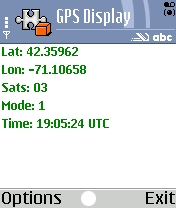N900 vs. Nexus One vs. iPhone
Posted in Mobile Platform, N900 on April 16th, 2010 at 21:38:48(The following opinions are my own, and not representative of my employer or anyone else.)
A friend asked me via email:
I noticed you’ve had your N900 for a while. I am thinking about upgrading from my iPhone 3G (it’s really slow — lots of lagging on UI) to a Nexus One or a N900. Have you had a chance to compare the two at all? Where did you get your N900? Any “killer apps” or major problems with it?
I don’t know if ‘5 days’ is ‘a while’ yet. 🙂 As for how I got it… well, perhaps you missed my previous post…
I think that upgrading from an iPhone — if you generally like the way it works, and are just upset about the UI speed/performance — will be a disappointment. I have an iPod Touch and the n900, and when I want to run an app real quick, the iPhone will win, hands down. The N900 has far more functionality to be excited about, but in general, there are still aspects of the iPhone that win. Basically: If you didn’t jailbreak your iPhone, you’re not looking for the ‘right’ kind of thing for an N900 to be the solution. (I didn’t jailbreak my iPod, but it’s a media player, not a communications device.)
I don’t have experience with the Nexus One. The G1 users in the office have commented repeatedly on how ‘fast’ the N900 response is by comparison: my understanding is that the Nexus One is a significant hardware step up from the G1, so that experience may be irrelevant. (G1 users also have said “If they just came out with a ‘G2’ that just had double the CPU + double the memory, I’d buy it in a heartbeat.”)
Before the recent events, I was considering the N900 or the G1. After playing with a G1 for a while, I realized that it — sort of like the iPhone, though to a lesser extent — is also not a general purpose computer. It’s closer, because it’s more open, but in the end, it’s designed as a ‘platform’, and that’s obvious in many aspects of how it works. The Maemo OS was always developed for Internet Tablets, and that shows in many aspects of the design. (This is also why it makes a somewhat sub par phone; although the OS has grown well into many aspects of the device, the ‘phone’ app is recent enough that it hasn’t had time to mature into that role.)
Overall: If you’re the type of person who wants to run a shell script, and display the results of a shell script on your phone’s desktop, the N900 may well be for you. (Really.) If you want a platform, but for something that’s designed originally as a phone, and with a much broader ecosystem and community — but more limitations ‘out of the box’ — the Nexus One may be for you, though that’s mostly hearsay. (I would consult a G1/Nexus One user for anything resembling a serious opinion here.) And if you want something pretty that isn’t going to require you to pop open a terminal to fix it when something breaks — the Apple way may be the right way for you.
Some cool aspects of the N900: two-way video calling with Google talk (but only when initiated from a computer, sadly). Two way audio-chat over Jabber. Built-in always-on IM clients. Exchange mail push support built in. (Exchange support in general is excellent; this includes both ‘real’ exchange and clones like Zimbra.) ‘apt-get install openssh’. Doom on the phone. High res screen, great for video playback.
Some things it doesn’t do well: Making it trivial to open the actual ‘phone’ part (hardware button) would be great. The lack of Facebook app is disappointing; the iPhone one was so good that I was spoiled by it. (I’m not a huge Facebook user, so this isn’t a deal breaker by any stretch.) The fact that there was not, until recently, a well-supported way of distributing non-open applications, means that there isn’t a lot of non-open application development — so fewer professionally done games, free or pay, than on a platform like the iPhone (and I assume fewer than on Android as well). That automatically implies that you cannot use Wordscape answers you get off of the internet in your iPhone. Ovi Maps, does not compare favorably to Google Maps in many cases, and running apps via the browser just doesn’t feel right. (This is a start, but not really ideal.) Battery life is poor, but that’s probably my own fault. 🙂
As a final point of comparison, the app community for the other devices doesn’t even compare to Apple’s in quantity. However, overall, the ‘decent, usable, free apps’ communities do seem somewhat larger on N900 than on Apple, in my experience. Finding something free on iTunes that’s worth downloading is hard — but the Maemo garage is full of fun, useful apps, and they’re all free.
I like the N900. It’s certainly not for everyone, but for me, I like having my communications device being a general purpose computer (so long as the phone part keeps working). There’s plenty of room to improve, but having a very open ecosystem reassures me that I may be able to contribute some of that, and overall, it fits the bill for being the most awesome thing to carry around in my pocket.
 If you’ve been asking this question, I’ve got software which has an answer for you.
If you’ve been asking this question, I’ve got software which has an answer for you.